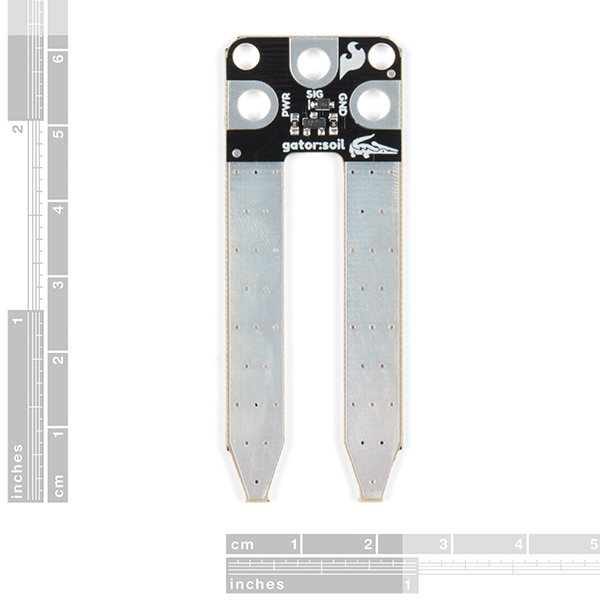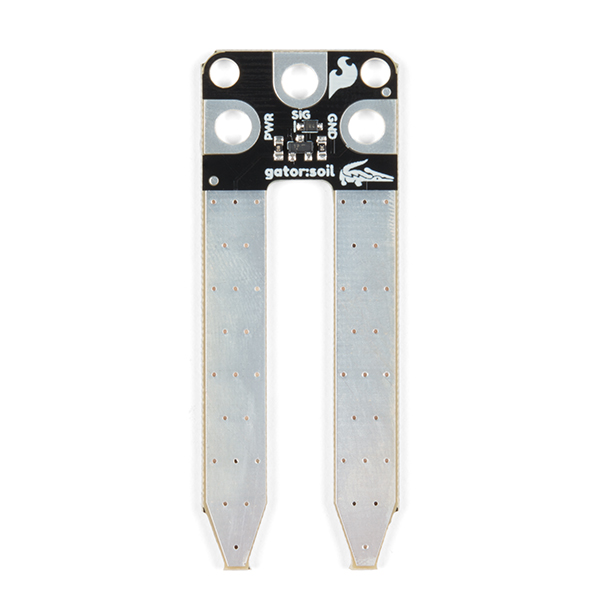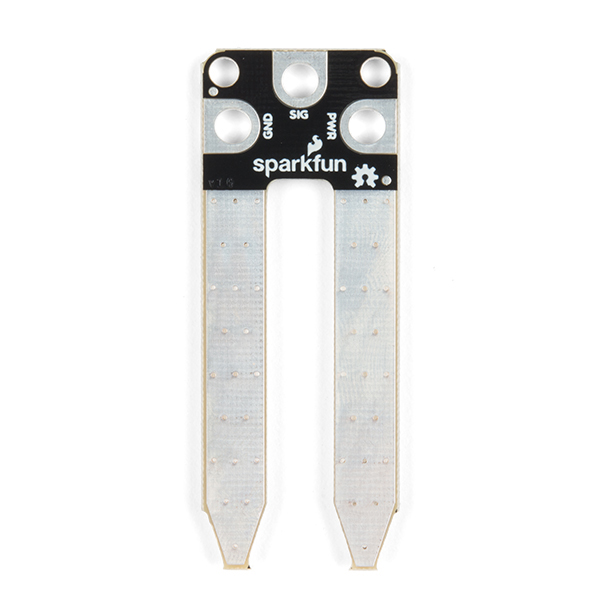SparkFun gator:soil - micro:bit Accessory Board
If your plants could talk, would they call out "Water me, Seymour?" Unfortunately (or fortunately, perhaps) plants have yet to develop the ability to speak. But thanks to the SparkFun gator:soil micro:bit Accessory Board, you can now measure the moisture level in soil without any vocal clamoring from your leafy lads. And, best of all--it is part of SparkFun's gator:bit series of alligator-clippable accessories, meaning you can easily interface it with the micro:bit or other microcontrollers!
The gator:soil consists of two probes and three pads (PWR, GND, and SIG). The probes are used to measure the conductivity of the soil. SIG provides an analog voltage out that can be attached to an ADC pad on the gator:bit (v2). The value read on SIG is dependent on a few variable, including soil composition, contact on the probes, soil compaction, and other factors. In most cases, it will behoove you to calibrate your sensor reading for each soil sample and sensor. Once calibrated, for a fixed sensor, the primary variables to measuring conductivity in the soil will be the power input and moisture content of the soil.
We recommend powering the gator:soil with between 3.3V - 5V. Again, please note that the analog value returned will vary depending on what voltage is provided for the sensor. For use with the gator:bit (v2) and micro:bit, you should provide 3.3V through the PWR and GND pads. We recommend not powering the sensor constantly to reduce corrosion of the probes; this can be controlled through one of the digital pins of the gator:bit (v2).
The micro:bit is a pocket-sized computer that lets you get creative with digital technology. Between the micro:bit and our shield-like bit boards you can do almost anything while coding, customizing and controlling your micro:bit from almost anywhere! You can use your micro:bit for all sorts of unique creations, from robots to musical instruments and more. At half the size of a credit card, this versatile board has vast potential!
- gator:bit Compatible
- Contacts:
- PWR: INPUT: Power to the sensor (3.3V-5V)
- SIG: OUTPUT: Analog voltage representing conductivity between probes
- GND: REFERENCE: Ground reference (0V)
- Probes: Used to sample soil moisture content for sensor
SparkFun gator:soil - micro:bit Accessory Board Product Help and Resources
Getting Started with the micro:bit
September 2, 2021
The BBC micro:bit is a compact, powerful programming tool that requires no software installation. Read on to learn how to use it YOUR way!
SparkFun gator:bit v2 Hookup Guide
January 31, 2019
The gator:bit v2 is a breakout board for the BBC micro:bit. The gator:bit exposes almost every pin on the micro:bit to clippable pad with circuit protection. It also has as built-in addressable LEDs and a built-in buzzer.
SparkFun gator:soil Hookup Guide
June 13, 2019
The gator:soil is analog soil moisture sensor. This tutorial will get you started using the gator:soil with the micro:bit platform.
Core Skill: Programming
If a board needs code or communicates somehow, you're going to need to know how to program or interface with it. The programming skill is all about communication and code.
Skill Level: Rookie - You will need a better fundamental understand of what code is, and how it works. You will be using beginner-level software and development tools like Arduino. You will be dealing directly with code, but numerous examples and libraries are available. Sensors or shields will communicate with serial or TTL.
See all skill levels
Core Skill: Electrical Prototyping
If it requires power, you need to know how much, what all the pins do, and how to hook it up. You may need to reference datasheets, schematics, and know the ins and outs of electronics.
Skill Level: Rookie - You may be required to know a bit more about the component, such as orientation, or how to hook it up, in addition to power requirements. You will need to understand polarized components.
See all skill levels
Comments
Looking for answers to technical questions?
We welcome your comments and suggestions below. However, if you are looking for solutions to technical questions please see our Technical Assistance page.
Customer Reviews
No reviews yet.




